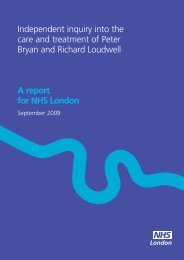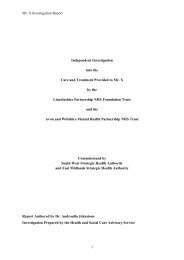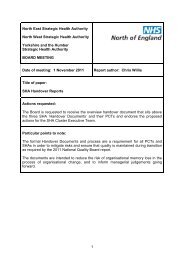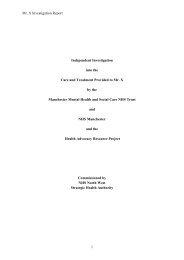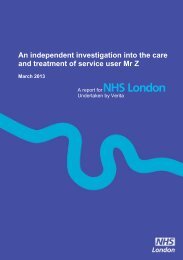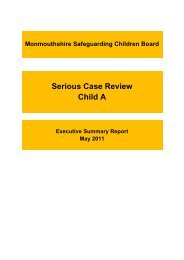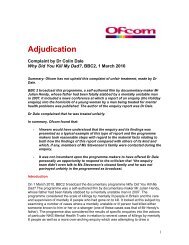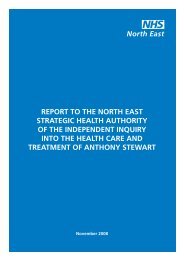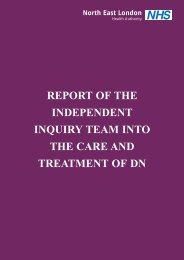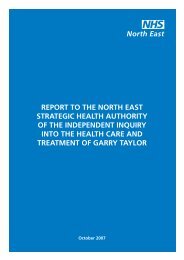Lousia Ovington independent investigation report ... - NHS North East
Lousia Ovington independent investigation report ... - NHS North East
Lousia Ovington independent investigation report ... - NHS North East
Create successful ePaper yourself
Turn your PDF publications into a flip-book with our unique Google optimized e-Paper software.
women. Registrar 1 prepared a very thorough summary, taking considerable trouble to<br />
collate as much information as possible, verbal and written, of Louisa <strong>Ovington</strong>’s past<br />
history. Consultant 11 from Kneesworth agreed that Louisa <strong>Ovington</strong> was suitable for<br />
treatment at Kneesworth and wished her to be transferred under the same Section<br />
38 Order which had been regularly renewed, but by the time of transfer had only five<br />
months to run. The former Tees Health Authority approved and funded the placement.<br />
74. During her stay at St Nicholas’ Hospital Louisa <strong>Ovington</strong> continued to have<br />
intermittent contact with her father.<br />
75. There was some social work input while Louisa <strong>Ovington</strong> was in Cuthbert Ward,<br />
primarily to provide a social circumstances <strong>report</strong> to Hospital Managers 35 . In March<br />
1999 Social Worker 1 (who had been her social worker for some months and had<br />
known the family for some time) handed the care to Social Worker 2 and a meeting<br />
is recorded on 1 March 1999 where it is commented that Louisa <strong>Ovington</strong> showed no<br />
remorse for her offences.<br />
COMMENT<br />
CHAPTER 1 - NARRATIVE OF KEY DATES AND EVENTS<br />
Cuthbert Ward was a forensic unit and proved to be a far more suitable and<br />
therapeutic environment for Louisa <strong>Ovington</strong> than the Tony White Unit. As a forensic<br />
unit they had the benefit of greater resources including a high staff to patient ratio,<br />
access to psychology, occupational and recreational therapy and a more spacious<br />
environment. She had the benefit of seeing her key worker regularly. She also<br />
benefited from being very closely supervised. Whilst it was acknowledged that Louisa<br />
<strong>Ovington</strong> was highly manipulative the panel was told that it was unlikely that she<br />
could have kept her true impulses and behaviour under control in this way for such<br />
a lengthy period of time. Consultant 9 told the panel that he had little doubt it was<br />
the very strict boundaries that made the difference and the fact that there was a zero<br />
tolerance of aggression.<br />
The care planning process identified key issues and how they should be addressed<br />
and this was supported by regular review meetings. The clinical care was entirely<br />
appropriate. Detailed medical and nursing records were kept. The handover to<br />
Kneesworth was well planned and executed.<br />
Given the above it was unfortunate that she had to be transferred away from St<br />
Nicholas’ Hospital. Consultant 9 told the panel that by a fairly early stage he had<br />
decided there was insufficient evidence of mental illness, (rather than personality<br />
disorder) being the primary diagnosis, but that he considered Louisa <strong>Ovington</strong> still to<br />
be sufficiently dangerous as to need conditions of medium security. He did not think<br />
that the facilities he had on Cuthbert Ward would meet her needs, particularly as it<br />
35 See Chapter 8<br />
27



